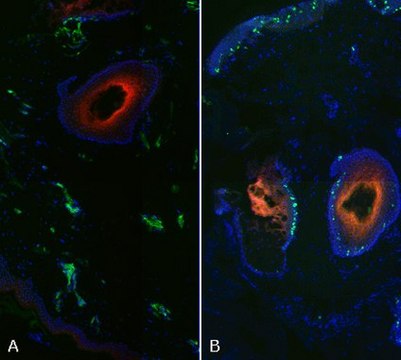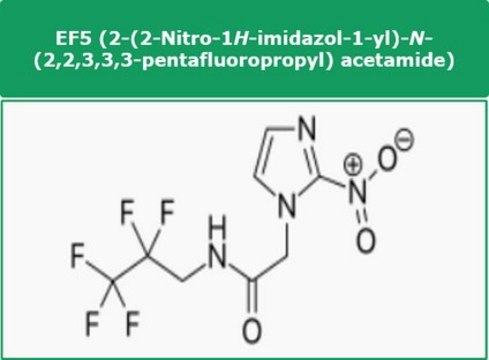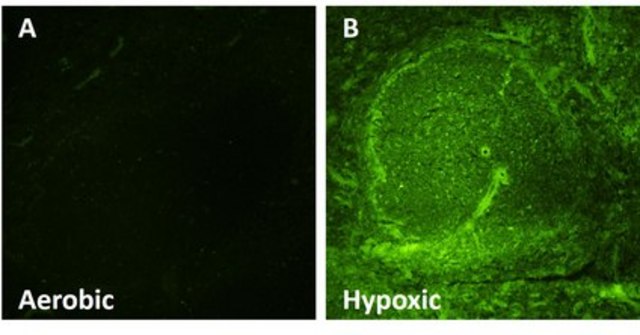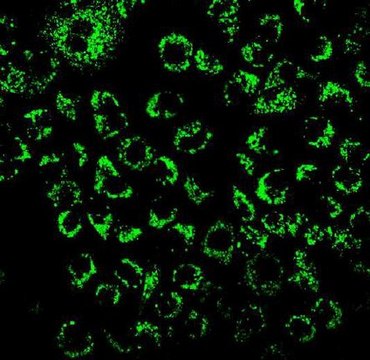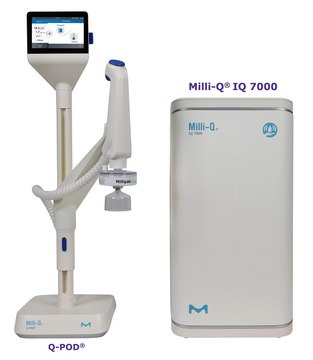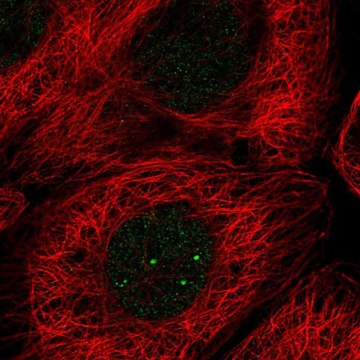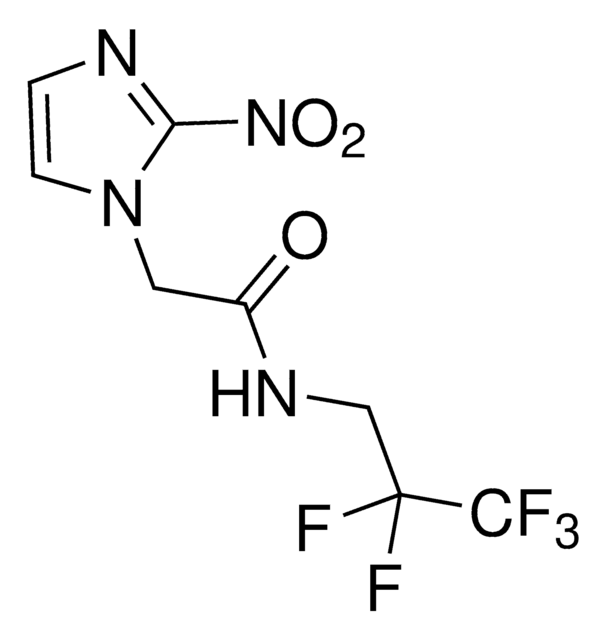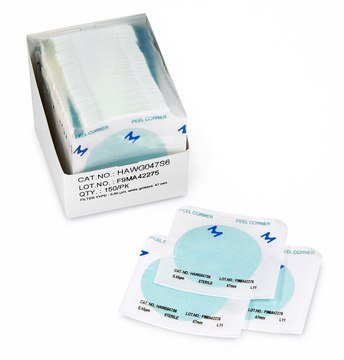EF5012
Anti-EF5 Antibody, clone ELK3-51 Antibody, Cyanine 5 conjugate
clone ELK3-51, from mouse, CY5 conjugate
Sign Into View Organizational & Contract Pricing
All Photos(1)
UNSPSC Code:
12352203
eCl@ss:
32160702
NACRES:
NA.45
Recommended Products
biological source
mouse
conjugate
CY5 conjugate
antibody product type
primary antibodies
clone
ELK3-51, monoclonal
species reactivity
human, rat, mouse
technique(s)
immunofluorescence: suitable
immunohistochemistry: suitable
isotype
IgG1
General description
A number of imaging markers which target hypoxia exist and are widely used in research. EF5 (2-(2-Nitro-1H-imidazol-1-yl)-N-(2,2,3,3,3-pentafluoropropyl) acetamide) is a compound developed at the University of Pennsylvania by Dr. Cameron Koch and Dr. Sydney Evans. Upon injection into animal tissues, EF5 selectively binds to hypoxic cells and forms adducts. A mouse monoclonal antibody, clone ELK3-51, which is directly conjugated to Cyanine 5, is then used to selectively bind the EF5 adducts providing a sensitive and quantitative method to detect and measure tissue hypoxia in animal and human tumors, normal tissues and cells.
Advantages of the EF5 hypoxia detection method:
• EF5 exists in only one form; Pimidozole, an alternative hypoxia marker, exists in two forms; one of which is charged and very hydrophilic, the other lipophilic. Pimidozole thus has a very complex biodistribution. In contrast, EF5 is lipophilic and uncharged and this allows very rapid and even tissue distribution.
• EF5 binding images can be calibrated to provide quantitative data on the pO2 values of each cell (1). The fluorescent images obtained from EF5 binding can be calibrated according to camera settings and a “cube-binding” value which is obtained through a separate procedure. The intensity values of calibrated images are directly related to actual tissue pO2 values. As a result, these images provide information regarding not only where hypoxic areas may or may not be, but also data regarding the distribution and levels of hypoxia.
Reference:
Koch CJ (2002) Measurement of absolute oxygen levels in cells and tissues using oxygen sensors and 2-nitroimidazole EF5. Methods in Enzymology 352: 3-31.
Advantages of the EF5 hypoxia detection method:
• EF5 exists in only one form; Pimidozole, an alternative hypoxia marker, exists in two forms; one of which is charged and very hydrophilic, the other lipophilic. Pimidozole thus has a very complex biodistribution. In contrast, EF5 is lipophilic and uncharged and this allows very rapid and even tissue distribution.
• EF5 binding images can be calibrated to provide quantitative data on the pO2 values of each cell (1). The fluorescent images obtained from EF5 binding can be calibrated according to camera settings and a “cube-binding” value which is obtained through a separate procedure. The intensity values of calibrated images are directly related to actual tissue pO2 values. As a result, these images provide information regarding not only where hypoxic areas may or may not be, but also data regarding the distribution and levels of hypoxia.
Reference:
Koch CJ (2002) Measurement of absolute oxygen levels in cells and tissues using oxygen sensors and 2-nitroimidazole EF5. Methods in Enzymology 352: 3-31.
Application
Anti-EF5 Antibody, clone ELK3-51 Antibody, Cyanine 5 conjugate is provided in a concentrated format at 2 mg/mL. For optimal performance, antibody should be diluted to a working concentration of at least 75 ug/mL. Refer to product datasheet for details.
Research Category
Cancer
Cancer
Research Sub Category
Hypoxia
Hypoxia
The EF5 hypoxia detection method provides a sensitive and quantitative method to detect and measure tissue hypoxia in animal and human tumors, normal tissues and cells.
Storage and Stability
Store at -20°C.
Other Notes
Concentration: Please refer to product datasheet.
Disclaimer
Unless otherwise stated in our catalog or other company documentation accompanying the product(s), our products are intended for research use only and are not to be used for any other purpose, which includes but is not limited to, unauthorized commercial uses, in vitro diagnostic uses, ex vivo or in vivo therapeutic uses or any type of consumption or application to humans or animals.
WGK
WGK 2
Flash Point(F)
Not applicable
Flash Point(C)
Not applicable
Certificates of Analysis (COA)
Search for Certificates of Analysis (COA) by entering the products Lot/Batch Number. Lot and Batch Numbers can be found on a product’s label following the words ‘Lot’ or ‘Batch’.
Already Own This Product?
Find documentation for the products that you have recently purchased in the Document Library.
Jérémy Verbeke et al.
The EMBO journal, 42(14), e112817-e112817 (2023-05-26)
The facultative intracellular pathogen Brucella abortus interacts with several organelles of the host cell to reach its replicative niche inside the endoplasmic reticulum. However, little is known about the interplay between the intracellular bacteria and the host cell mitochondria. Here
Articles
Hypoxia detection assays to measure oxygen levels in both live and fixed cells and tissues.
Our team of scientists has experience in all areas of research including Life Science, Material Science, Chemical Synthesis, Chromatography, Analytical and many others.
Contact Technical Service
